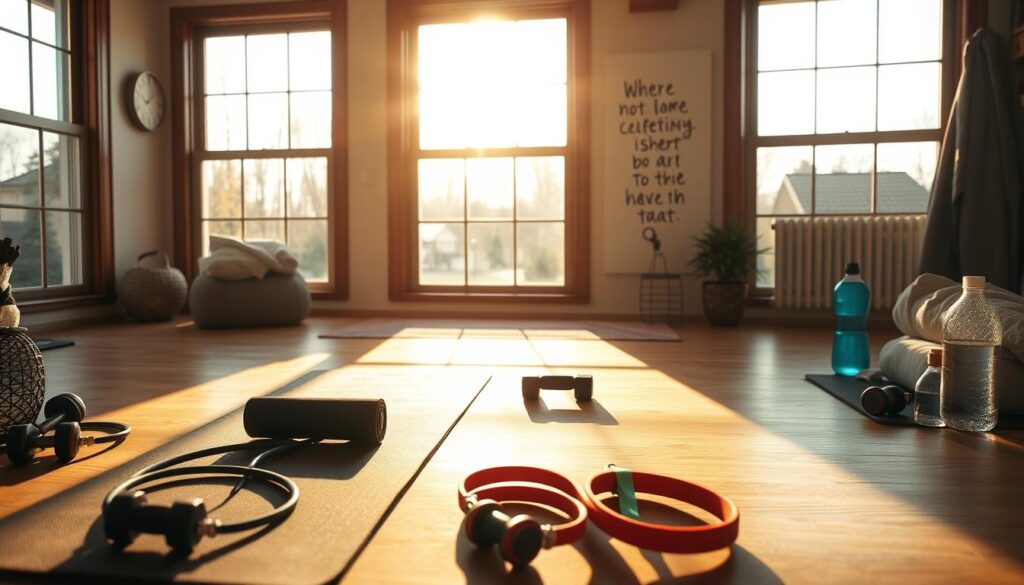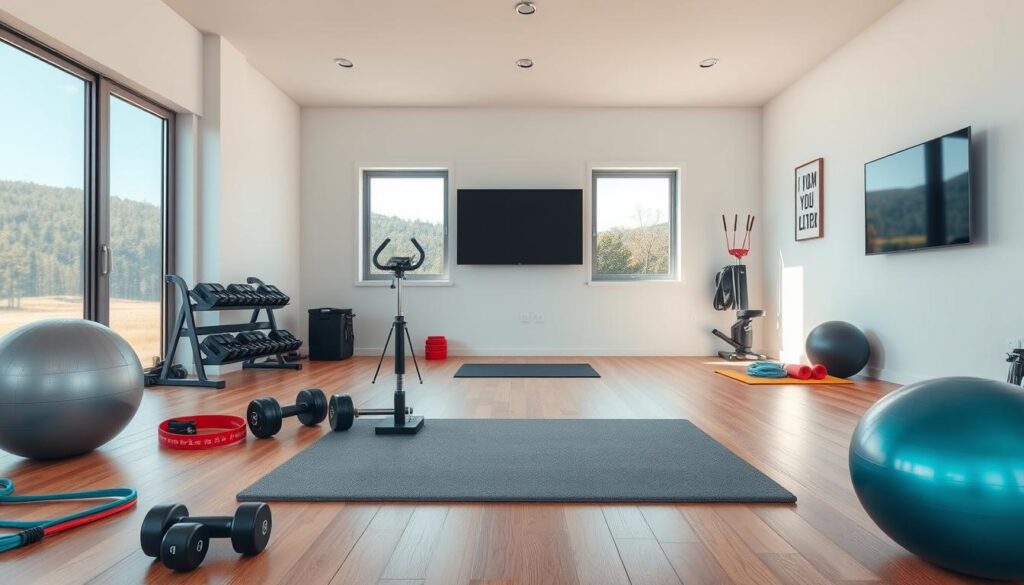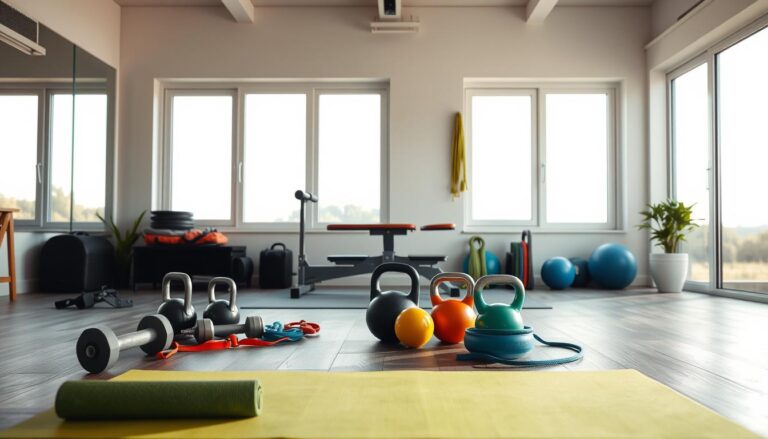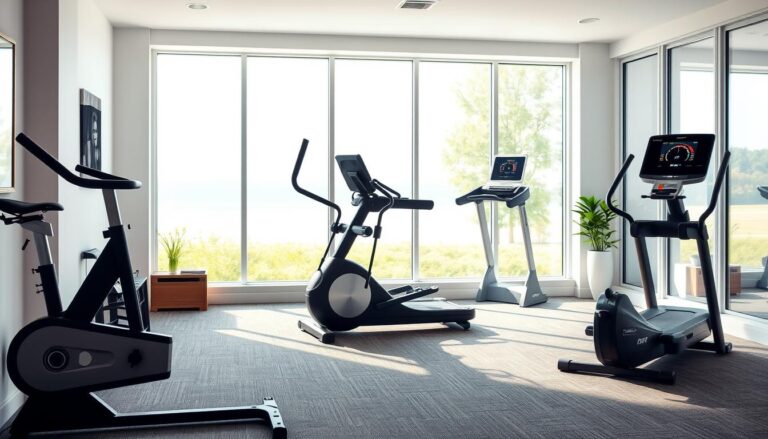Stay Motivated with Any Fitness Routine at Home
Finding the motivation to work out at home can be tough. The couch is comfy, and distractions are everywhere. But, the right mindset and habits can help.
Convenience, customization, cost savings, and privacy are big pluses of home workouts. Knowing these benefits and the challenges helps prepare for a successful home workout.
Creating a good environment is key for a successful home workout. With the right strategies, you can overcome distractions and stay on track.
Key Takeaways
- Convenience is a big plus of home workouts.
- Customization lets you tailor workouts to your needs.
- Cost savings come from avoiding gym memberships.
- Privacy is a big plus when working out at home.
- A good environment is crucial for motivation.
- Having the right mindset is key for success in home workouts.
The Challenge of Home Fitness Motivation
Getting motivated for home workouts is tough. The ease of working out at home can also be a problem. It brings challenges that can slow you down.
Common Obstacles to Consistent Home Workouts
Several factors can make it hard to stay motivated for home workouts. Two big challenges are:
- Distractions and Interruptions: Home is full of distractions, like chores and family members. This can interrupt your workouts.
- Lack of Equipment or Space: Not having enough space or the right equipment can make it hard to keep up with workouts.
Distractions and Interruptions
Creating a good workout space at home is key. It’s important to reduce distractions and make sure others respect your workout time. Try working out when it’s less busy or use headphones to block out noise.
Lack of Equipment or Space
Even with limited space or equipment, there are many effective workout options. You can do bodyweight exercises, use resistance bands, or follow online videos. Being creative and flexible with what you have is important.
The Psychology Behind Fitness Motivation
Understanding why you’re motivated to work out is key. It’s about knowing what drives you. Intrinsic motivators, like feeling good about yourself, are especially important for sticking with home workouts long-term.
Why Traditional Motivation Methods Often Fail at Home
Methods that work in gyms don’t always work at home. The lack of a structured gym atmosphere and the comfort of home can make it hard to stay motivated. So, it’s important to find motivation strategies that work for home workouts.

Creating Your Ideal Home Workout Environment
Turning your home into a fitness spot can change your workout game. Having a special area for exercise boosts your motivation and discipline. This helps you reach your fitness goals faster.
Designating a Dedicated Fitness Space
Having a dedicated fitness area at home is key for regular workouts. This space should be free from distractions. It should be quiet, well-ventilated, and have a mirror for checking your form.

Essential Equipment vs. Nice-to-Have Items
When setting up your home gym, know the must-haves from the nice-to-haves. You’ll need a good yoga mat, dumbbells, and a resistance band for many exercises. Nice-to-haves like a treadmill or a multi-functional gym machine can make workouts better but aren’t essential for beginners.
Optimizing Your Space for Different Workout Types
Setting up your home gym for various workouts keeps your routine interesting. Make sure your space is ready for strength training, cardio, and yoga or flexibility exercises.
Strength Training Setups
For strength training, you’ll need dumbbells or a home gym with different resistance levels. A sturdy bench or a Swiss ball can also be helpful for some exercises.
Cardio-Friendly Arrangements
For cardio, you can get a treadmill or a stationary bike, or do bodyweight exercises like jumping jacks or burpees. Make sure you have enough room to move freely.
Yoga and Flexibility Spaces
Yoga and flexibility exercises need a quiet, peaceful spot with a good yoga mat. Consider getting a yoga block or a strap to help with your form and flexibility.
Setting SMART Fitness Goals for Home Workouts
The key to staying committed to fitness at home is setting clear goals. These goals should be Specific, Measurable, Achievable, Relevant, and Time-bound.
Setting these goals helps you create a roadmap for your fitness journey. It keeps you focused and motivated.
Defining Specific and Measurable Objectives
To maintain motivation for home exercise, define specific and measurable goals. For example, instead of saying “I want to be healthier,” say “I will reduce my body fat percentage to 25% in 6 months.” This makes your goal clear and lets you track your progress.
- Identify your fitness goals: weight loss, muscle gain, or endurance improvement.
- Quantify your goals: e.g., lose 10 pounds in 3 months or run 5 miles without stopping.
Creating Realistic Timelines for Progress
Setting a realistic timeline is key to staying motivated. Setting unrealistic goals can lead to disappointment. Consider your current fitness level, workout time, and lifestyle when setting your timeline.
Adjusting Goals as You Advance
As you get better, adjust your goals. Check your progress and decide if you need to increase the challenge or change your goals if you hit a setback.
When to Scale Up Your Challenges
If your current goals are too easy, it’s time to make them harder. You might increase workout intensity, add new exercises, or set a new goal.
How to Modify Goals During Setbacks
Setbacks happen, but they shouldn’t stop you. Modifying your goals can help you stay on track. You might adjust your timeline, change your workout routine, or get professional help.
- Re-evaluate your goals during setbacks.
- Adjust your goals based on your current circumstances.
Designing a Sustainable Home Fitness Schedule
Creating a home fitness schedule that lasts requires careful planning. It’s about knowing your lifestyle, what you like, and your fitness goals. This way, you can stick to it for a long time.
Finding Your Optimal Workout Time
Finding the best time to work out is key for staying consistent. Whether you like mornings or evenings, pick a time that fits your schedule. Studies show that being consistent is more important than when you work out.
“The key to a successful home workout routine is not just about the time you spend exercising, but also about being consistent with it.”
Balancing Different Exercise Types
A good fitness routine has strength training, cardio, and flexibility exercises. This mix is vital for staying fit and avoiding plateaus.
Strength, Cardio, and Flexibility Mix
Your home workout should include strength training, cardio, and flexibility. You can set aside specific days for each or mix them. For example, you might do strength training one day and cardio the next.
| Exercise Type | Benefits | Examples |
|---|---|---|
| Strength Training | Muscle Building, Metabolism Boost | Push-ups, Squats, Lunges |
| Cardio | Heart Health, Calorie Burn | Running, Cycling, Jumping Rope |
| Flexibility | Improved Mobility, Injury Prevention | Yoga, Stretching Exercises |
Intensity Variation Throughout the Week
Changing the intensity of your workouts can prevent burnout and help you progress. You might have high-intensity days followed by easier or rest days.
Building Rest and Recovery Into Your Plan
Rest and recovery are just as important as working out. Make sure you have enough rest days and include stretching or foam rolling. This helps your body recover and adapt.
By adding these elements to your home fitness plan, you can make a routine that supports your goals. This not only improves your physical health but also boosts your mental well-being. It’s a motivation hack for home fitness that really works.
How to Stay Motivated with Any Fitness Routine at Home
To reach your fitness goals at home, you need the right workout and motivation. Keeping up with a home workout routine means building daily habits. These habits should show your dedication to exercise.
Daily Habits That Reinforce Commitment
Creating a routine with daily habits like planning workouts and tracking progress helps. Consistency is key to staying committed to home workouts.
Reward Systems That Actually Work
Using a reward system can boost your motivation. It includes short-term and long-term rewards.
Short-term Incentives
Short-term rewards, like treating yourself to a favorite meal or a relaxing bath after a weekly goal, motivate you right away.
Long-term Reward Structures
Long-term rewards, like signing up for a marathon or achieving a specific fitness milestone, keep you motivated for longer.
Visualization and Mindset Techniques
Visualization and mindset techniques are also important. Visualizing your fitness goals and staying positive helps you stay focused and motivated.
Overcoming the “Motivation Dip” After Initial Excitement
After the excitement of starting a new workout routine fades, you might feel a motivation dip. To beat this, have a strong reward system and keep your routine fresh and challenging.
Tracking Progress Beyond the Scale
Success in home workouts isn’t just about the scale. It’s about progress in many areas. Focusing only on weight loss limits your view of progress.
Effective Metrics for Measuring Success
To stay motivated, track progress with different metrics. This gives a full view of your fitness journey.
Performance-Based Measurements
Performance is a key metric. Track your exercise performance over time. This includes reps, weight lifted, or workout time.
For example, if you run at home, track your pace and distance.
Body Composition Changes
Body composition is another important metric. It shows changes in body fat, muscle mass, and more. Use methods like dual-energy X-ray absorptiometry (DXA) and bioelectrical impedance analysis (BIA) to track these changes.
| Metric | Description | Example |
|---|---|---|
| Performance-Based Measurements | Tracking exercise performance over time | Running time, number of repetitions, weight lifted |
| Body Composition Changes | Measuring changes in body fat percentage and muscle mass | DXA, BIA |
Using Technology to Monitor Improvements
Technology helps track progress. Fitness apps and devices monitor workouts and provide insights. Use a fitness tracker for daily activity, sleep, and heart rate.
Celebrating Non-Scale Victories
Celebrate non-scale victories for motivation. These include better energy, sleep, and overall well-being. Acknowledge and celebrate these to stay motivated.
By tracking progress with technology and celebrating victories, you’ll stay motivated. Consistency and patience are key to success in home workouts.
Overcoming Common Home Workout Plateaus
To break through a workout plateau, you need a new approach and a willingness to change. Working out at home can make it harder to stay motivated and overcome the plateau.
Recognizing When You’re Stuck
First, you must recognize if you’re stuck. This might happen if you’re not seeing progress, feeling less motivated, or getting bored with your routine. Pay attention to your body and mind; if you’re not feeling challenged, you’re likely plateauing.
Strategies to Break Through Plateaus
There are a few ways to get past a plateau. Two main strategies are Progressive Overload Techniques and Workout Variation Methods.
Progressive Overload Techniques
Progressive overload means slowly increasing the weight, resistance, or reps to challenge your muscles. You can do this by:
- Increasing the weight or resistance you’re using
- Adding more repetitions or sets
- Decreasing rest time between sets
Workout Variation Methods
Changing your workout routine can also help. This can include:
- Switching to a different exercise that targets the same muscle group
- Changing the order of your exercises
- Incorporating different training methods, such as HIIT or plyometrics
| Strategy | Description | Benefits |
|---|---|---|
| Progressive Overload | Increase weight, reps, or sets over time | Stimulates muscle growth and strength gains |
| Workout Variation | Change exercises, order, or training method | Prevents boredom, challenges different muscle fibers |
| Rest and Recovery | Adequate rest between workouts | Prevents overtraining, allows muscle recovery |
When and How to Change Your Routine
It’s important to change your routine when you’re not making progress or feeling bored. Change your routine every 4-6 weeks to keep your workouts exciting and avoid plateaus.
By recognizing when you’re stuck, using strategies to break through, and knowing when to change your routine, you can overcome common home workout plateaus. This way, you can stay motivated with your at-home fitness routine.
Leveraging Technology and Community for Accountability
Staying fit at home needs more than just a good workout plan. It also needs a strong support system. Today, technology and community can help a lot. There are many tools and platforms that keep people motivated and on track with their fitness goals.
Best Fitness Apps for Home Workout Motivation
Fitness apps are great for staying motivated. Apps like Nike Training Club, JEFIT, and Fitbit Coach offer various workouts. They have features like tracking your progress and connecting with others, which really helps.
Virtual Workout Communities and Challenges
Joining virtual workout communities and challenges is also helpful. Many apps and online platforms have these. They let you connect with others who have the same fitness goals. This sense of belonging and support is a big motivator.
Creating Accountability Partnerships
Creating accountability partnerships is another good idea. Find someone who can support and motivate you. Having a workout buddy can really help you stay on track.
Finding the Right Accountability Partner
To find the right partner, look for someone with similar fitness goals. It could be a friend, family member, or colleague. Online fitness communities are also great places to find people with similar interests.
Setting Up Effective Check-in Systems
After finding a partner, set up a good check-in system. This could be regular video calls, workout logs, or tracking progress. A structured system helps keep you motivated and on track with your fitness goals.
Exercise database, workout tracking, progress monitoring
| Fitness App | Key Features | Cost |
|---|---|---|
| Nike Training Club | Variety of workouts, training plans, workout tracking | Free |
| JEFIT | Free/ Premium | |
| Fitbit Coach | Personalized video workouts, progress tracking | $7.99/month or $39.99/year |
Conclusion: Building a Lifelong Home Fitness Habit
Creating a lifelong home fitness habit takes time and effort. It means staying committed to exercise and being ready to face challenges. By being consistent and overcoming obstacles, you can build a lasting home workout routine.
It’s important to be patient and celebrate small wins. Daily habits and reward systems can help keep you motivated. Technology and community support also play a big role in staying on track.
A successful home fitness habit is about being consistent, resilient, and adaptable. With a positive mindset, you can enjoy lasting benefits for your body and mind.
FAQ
Q: How can I stay motivated with my home workout routine?
To stay motivated, mix daily habits, rewards, and mindset tricks. Make your workout area great and set clear fitness goals. This keeps you going.
Q: What are some common obstacles to consistent home workouts?
Distractions, lack of gear, and losing motivation are big hurdles. But, discipline, creativity, and smart plans can beat them.
Q: How can I create a conducive workout environment at home?
Make a special fitness area free from distractions. Add the right gear for all your workouts. This makes your space versatile and effective.
Q: What are some effective metrics for measuring progress beyond the scale?
Look at how well you perform, changes in body shape, and feel better overall. Tech can track these changes, keeping you motivated.
Q: How can I overcome a plateau in my home workout routine?
Recognize when you’re stuck and try new things. Increase weights or reps, and mix up your workouts. This can get you moving again.
Q: Can I get motivated and stay accountable with a home workout routine without a personal trainer?
Yes, tech and community can help a lot. Use fitness apps, join online groups, and find workout buddies. This adds motivation and support.
Q: How often should I adjust my home workout routine to stay motivated and avoid plateaus?
Adjust your routine when you hit a wall or reach your goals. This keeps you moving and avoids getting stuck.
Q: What are some strategies for building rest and recovery into my home fitness plan?
Balance your workouts and include rest days. This prevents burnout and lets your body recover and grow stronger.
Q: How can I stay motivated with my home workout routine over the long-term?
Stay motivated by being consistent, creative, and using the right strategies. Overcoming challenges and keeping a positive mindset helps you stick with it for life.






